~~~~~~~~~
The Story of Polioptics is a 10-part Web narrative based on a multi-media presentation — POLIOPTICS: Political Influence Through Imagery, From George Washington to Barack Obama — that debuted on college campuses in 2009.
The last post brought us up through the 2004 election, George W. Bush’s defeat of John Kerry. By 2008 standards, it was antiquated. By 2012 standards, it will probably be considered prehistoric.
Every election cycle will bring with it dramatic new advances in message-sending technology, but 2004 may go down as the last one fought primarily on the traditional media battleground. After all, Facebook back then was still slowly coursing its way through college campuses rather than the home of more than 500 million members and the subject of a blistering new film from West Wing creator Aaron Sorkin.
The 2004 election was so…old media. The concerted attack on Senator Kerry was, after all, the Swift Boats paid media campaign. True, the Swift Boat ad buy was small, comparatively, to the expenditure of the nominated Republican and Democratic candidates. But it undermined the Kerry campaign through endless repetition, for free, on broadcast airwaves and through the cable pipe into voters’ homes via political programming. In 2008, the Swift Boat effort would have gone viral much faster, as the less effective “Celeb” ad did from the McCain campaign that tried to compare Barack Obama to Paris Hilton.
And what will happen in 2012. Will the “October Surprise” turn into the “November Surprise,” or even the “Election Day Surprise”? The killer message can now speed through the Web and land on a smart-phone at the speed of light.
The old pollster in me can’t resist proffering a few questions:
[poll id=”2″]
[poll id=”3″]
Think about what’s happened to news delivery since the 2004 election. You’re not the only one thinking about it. For traditional media companies, it’s a life or death issue. If these questions were asked of a large group of politically engaged voters in 2003, the percentage of those answering “yes” would likely have been very small. Today, among the general population, the number of those answering ‘yes’ is on a steady climb.
In 1996, when we were “Building a Bridge to the 21st Century” for President Clinton and Vice President Gore, the Internet was a non-factor in political combat. Campaigns erected Web sites populated with static stuff: bios, phone numbers, issue papers. Records show the Clinton re-elect raised only $10,000 on the Web.
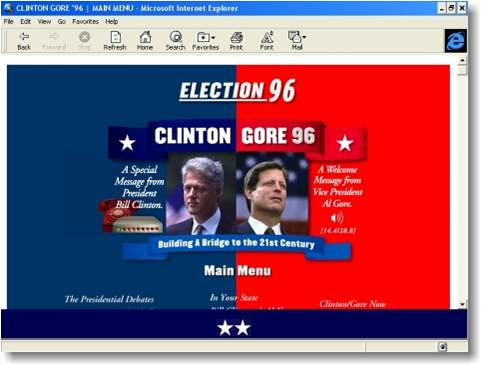
The Clinton/Gore 1996 Home Page
Now move forward four years. In 2000, John McCain won New Hampshire. When he accepted the victory, he did so from a podium that bore his site’s URL. That event was seen on live television across the country. Promoting a Web address through free media was a totally new idea at the time. Yet there it was: a shrewd McCain staffer thought to paste the URL on a placard in a position that no lens could miss. A viewer at home, inspired to join McCain’s cause, might make a brief note of the address and go online later to make a donation. One event in New Hampshire yielded free exposure to 49 other states and encouraged immediate action. The result: a $2.2 million online haul in a week.
Add on four more years, and Howard Dean showed the country how the Internet could organize volunteers on a national scale.
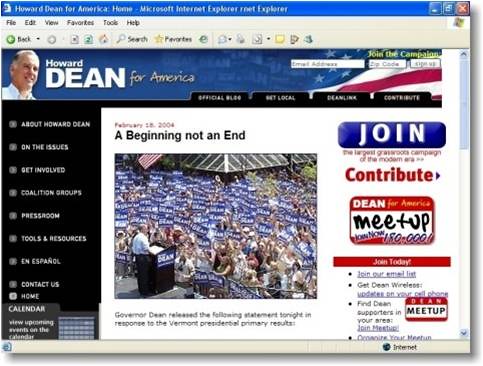
Howard Dean’s 2004 Home Page
Now moving forward one more time, to 2008, Barack Obama raised half a billion dollars online through his Website.
For Obama, and Mitt Romney, the Internet also became a movie theater. Traveling in Iowa in 2007, I ran across Michael Kolowich following Governor Romney at the Iowa State Fair. Dressed like Survivor’s Jeff Probst, with grey hair and toting an advanced mini high-definition camera from Sony, he seemed anything like the lumbering cameramen who wielded cameras the size of small tree trunks in Bill Clinton’s day. Michael told me was a friend of Mitt’s and gathering footage for something called MittTV. Back at my hotel room, I logged on to see what he had produced. Combining his fresh footage, music and voice-over while sitting in an airport waiting lounge, Kolowich cut together a news-quality mini-documentary presented in 16×9 aspect ratio and streaming in its own online player.
Back in 1992 working for Governor Clinton, much was made about how that campaign was trying to bypass traditional media, but the spin was always more than the reality. In 2008, Kolowich was finally making real headway, producing entertaining shorts and posting them to the Web. You had to be interested enough in Mitt Romney to go online and look for MittTV, but for those who made the effort, the videos offered a more expansive portrait of the candidate and his family than the networks or cable news would ever air. It was only a matter of time, I thought, before such content was readily pushed directly to the handheld screens of the voting public.
Elsewhere on the trail, traditional reporting was also losing ground. The most experienced reporters still worked for the major newspapers, but those newspapers were no longer the first place that readers went for information. Even their Websites were being bypassed. You might end up at the same place, but getting there now included a trip though the sites of media news sites and aggregators that linked to all of the relevant reporting on a single subject from across the mainstream media landscape. Case in point: when Senator Edward M. Kennedy died in August, 2009, the Washington Post offered a rich source of coverage, but it was easier to see the range of reporting by first visiting fivethirtyeight.com, Politico and, of course, Drudge, whose site offers the closest facsimile of the experience walking past a newspaper box of old.
It’s the ultimate media cliché that a picture is worth a thousand words, and it’s one that I’ve avoided addressing so far in the Story of Polioptics, but its enduring presence in our lexicon speaks to its truthfulness. Online resources trace it, perhaps erroneously, to a Chinese proverb, but it may have come to prominence in an old advertising trade journal. The December 8, 1921 issue of Printer’s Ink included an article by Fred R. Barnard entitled “One Look is Worth A Thousand Words” in which the author discussed promotions that adorned streetcars. Even Napoleon Bonaparte said, “Un bon croquis vaut mieux qu’un long discours,” or “A good sketch is better than a long speech.”
Whatever its origin, the digital content chiefs of the modern presidential campaign have picked up on the idea, providing more content — in the form of videos, photo galleries and Flickr feeds — than newspapers had resources to gather or room to cover. On the surface, the Obama Websites and mobile apps from 2008 provided an attractive portal to learn more information about, contribute to, and volunteer for the candidate. Digging a little deeper beneath the surface, though, is a still-vibrant Obama Flickr photostream that, as of this writing, contains nearly 56,000 images, stretching from the present to the earliest days of the campaign in 2007. Each one of them, in its own way, offers a front row look or a backstage view of Obama’s campaign shot by his staff, volunteers or sympathizers. This volume of content was never available from newspapers or cable networks, and likely never will be, but it’s now out there for anyone to see.
This Bill Clinton-era concept of bypassing the traditional media only increased as the 2008 Obama Campaign gave way to the 2009 Obama White House and as BarackObama.com transitioned to WhiteHouse.gov. In the effort to pass comprehensive health care reform legislation, the White House Website included new features with streaming video from White House aides or citizens designed, as the site said, to combat “a lot of misinformation being spread by defenders of the status quo.”
The experiments begun by Michael Kolowich and others in the 2008 campaign have now become a part of official government Websites.
Compare that to the White House site in Clinton’s day. It’s like looking at Alexander Graham Bell’s contraption and putting it up against the Droid.
The use of video in politics was building toward this for a while. It was clear where things were headed in December 2006 when Senator Obama deadpanned this introduction to a nationally-televised football game.
Perfect delivery. Perfectly pitched. Perfect production quality (including a dolly shot). Nice musical score. No journalistic filter. The trend continued as Hillary and Obama launched their campaigns from their living rooms, spread virally to contributors. It was unprecedented, but soon became the standard. Even Fred Thompson lent his considerable actor’s cadence to the mix. Hillary went so far as to recruit Vince Curatola from The Sopranos to tease her campaign song.
On assignment from Men’s Vogue in the summer of 2007, I headed to Iowa to see how campaigning was being waged for, and through, the lens. I saw Hillary’s campaign cover all the basics: fill a high school school gym; put a cross-section of voters in the bleachers; wade into the audience for questions; include in the backdrop a few well-chosen, easily digestible words and; of course, don’t forget the American flag, hung vertically to recall a Joint Session of Congress. But unlike the Romney or Edwards campaigns, she didn’t have a trailing videographer to capture video for a quick-turn edit and post to her Website.
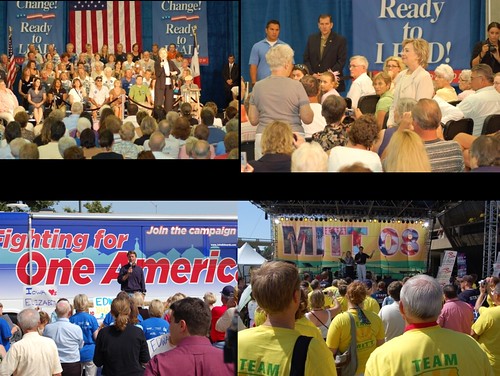
Images of the Iowa campaign
By contrast, over the course of my heartland visit, Obama skirted the bigger cities, opting instead for rustic enclaves. In the rural town of Atlantic, Iowa, his team passed up an air-conditioned hall for, literally, a stockyard. Wooden rafters. Dusty floor. Rickety chairs. Hand painted signs on butcher paper. Soft lighting. Theater, really, in the round. Let the other guys fill the cinder block gymnasiums or add machined backdrops and advanced production elements. The Obama campaign was going for an image of authentic grassroots interest, and what better place to promulgate that than an event site with a dirt floor?
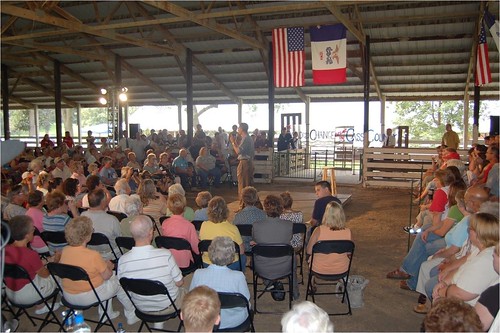
An Obama campaign event in Atlantic, Iowa
Obama’s stop in Atlantic might have been looked at by other campaigns as a throwaway event. It was in the afternoon, on a Saturday at the end of a long week, and destined for little real-time news coverage. Sure, a few news photos would make it to the national wire, but it was unlikely any of them would grace a front page or be seen as “the shot of the day.” But for filmmaker Amy Rice, who was trailing along filming her documentary for HBO, the rural scene fit perfectly with the movie’s title, “By The People.” Moreover, stops like this allowed the campaign to post even more content on the Obama Flickr photostream, adding to the frame-by-frame story of a candidate connecting at the grass- and net-roots.
From those determinedly rural beginnings, a more-polished, mass-marketed, standardized Obama event emerged. While opponents tinkered with the look and feel of their events, focusing more on word choice for their backdrops than on the totality of event design and choreography, Obama’s “Change We Can Believe in” set, with its Gotham typeface against a blue field, was rigidly consistent — hypnotic, by design.
And here is where traditional campaigning segues to incredibly disciplined marketing. Obama wasn’t just “staying on message” through what he said; he was staying on message in how he looked. His campaign understood how to breed warmth and acceptance: Create a tested presentation; perfect it over time; stay with it relentlessly knowing that style and repetition breed familiarity.
One more tool Obama relied on, and does still, is the TelePrompTer. In 1959, the producer of I Love Lucy, Jess Oppenheimer, filed Patent #2883902, a device to help performers memorize scripts. In Clinton’s White House, prompters were the exception, used only for only big events. Mindful of the President’s propensity to veer off script, there were many who thought he should use them more. But the counterarguments were that:
1) They’re expensive;
2) They’re complex;
3) The glass paddles on which the script is projected look bad on video and in stills (and this is true), and;
4) They’re perceived as a crutch.
Additionally, like any technology, they’re also prone to the inevitable screw ups that come from speeches with multiple revisions and prompter operators who aren’t fully in sync with the speaker.
One of the most famous prompter snafus came on September 22, 1993. President Clinton was addressing a Joint Session Congress on his proposed health care legislation but the wrong speech was loaded into the machine. Several aides noticed the problem backstage as Clinton turned quizzically to Vice President Al Gore who was seated behind him. With Congress, and the world watching on live television, the show had to go on. He delivered the first part his speech largely from memory until the problem could be fixed.
The Obama Campaign (and now his White House) had a considered view about production and performance of live events: hitting the right phrase, in the right cadence, whether speaking to a Joint Session of Congress or a crowd in a corn field, is worth risking the downsides of using a TelePrompTer. Does Obama take criticism in certain circles for doing this? Of course. There are Websites and blogs devoted exclusively to the subject, but until former Vice President Walter Mondale chimed in, very little of the criticism had crossed into the mainstream. Instead, what does make a difference is the considerable production advantage from the TelePrompTers and their Army-trained operators supplied by the White House Communications Agency. When the event starts, the cameras are always rolling and the world is always watching, and the president rarely trips over his message. During 2008, the Clinton and McCain campaigns didn’t embrace the tools of television production. In comparison, Obama, like an anchorman, delivered perfectly polished paragraphs each time out.
With increasing frequency, candidates at many levels from both parties are taking to the stage with the aid of a TelePrompTer. Sarah Palin must know her delivery is better with a prompter, as cluttered it may sometimes look with the glass paddles erected between her and the cameras. And following his win in the 2010 Arizona Republican primary, John McCain, who was rarely seen with a TelePrompTer two years ago, had it front and center for his victory speech, his eyes often glued to scrolling prompter.
It may offend some people’s sensibilities, but even great candidates need great production in a video age when appearance counts and every sentence might become the soundbite for the evening news. Indeed, in the Internet age, every appearance may bypass the evening news and be posted online in its entirety, from introduction to conclusion. The state-of-the-art of political production is passed down among advance people from generation-to-generation. Political practitioners of a certain age got their first taste of the do’s and don’ts of the campaign trail from Jerry Bruno’s long-out-of-print memoir of his globetrotting years with John F. Kennedy called The Advance Man. In 1998, I collected some of the best lessons passed down to me organized them into a booklet, “Notes on Creating Visuals & Presidential-Style Communications,” elements of which have been incorporated into the advance manuals of subsequent campaigns, including that of Senator Obama.
The Obama election night rally in Grant Park on November 4, 2008 incorporated many of the timeless lessons of political production, and elevated them to a new level.
When the president-elect’s acceptance speech ended, the music that played immediately after he finished speaking wasn’t an instantly-recognizable song from Bruce Springsteen, U2 or Motown, to which some advance people gravitate believing, mistakenly, that it will elevate an event. Rather, the music at Grant Park was the instrumental soundtrack theme from a moderately successful 2000 Denzel Washington movie, Remember the Titans, which is based on the true story of African American football coach Herman Boone and how he brought together the racially divided football team at T.C. Williams High School in Alexandria Virginia. Obama had visited T.C. Williams earlier in the campaign and gave a shout-out to Coach Boone. And in Denver, when Obama accepted the Democratic Nomination at Invesco Field, another track from the album was played.
All the elements of packaged political persuasion came together in Chicago at Grant Park, in many respects a perfect event.
Section 11 of my booklet on creating Presidential-style communications focuses on music. It reads, in part, “Leave the audience with a mature, adult sound in their ears.” That sums up the entire Obama 2008 effort: a mature, adult production in all respects – Internet, the stage set, strategic use of prompter, even music at Grant Park – all pivotal ingredients of Obama’s victory.
As the Obama team savored victory, for some a new question arose: how would the elements of visual production, so successful in a presidential campaign, translate to the everyday work of government in the White House? We’ll take up that question in the next post.
~~~~~~~~~~
If you missed earlier parts of the the Story of Polioptics, begin at the beginning with Polioptics Part 1, Part 2, Part 3, Part 4, Part 5 and Part 6.
And then continue reading The Story of Polioptics. Additional parts of the narrative will appear every few days. When it’s complete, it will be archived it its own section of www.Polioptics.com.
Stay tuned for upcoming posts:
Part 8: The First 100 Days…And the Next Thousand
Part 9: Port of Spain
Part 10: Homage to Image
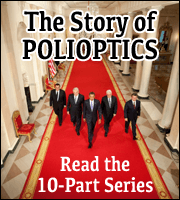
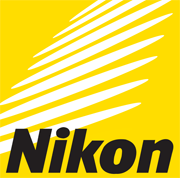
Leave a Reply